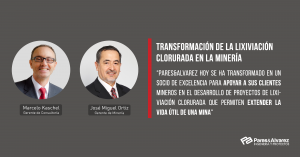WITH A YIELD OF UP TO 80% IN COPPER: THE BET ON CHLORIDE LEACHING IS CONSTRUCTABILITY
- Home
- What´s New
- With a yield of up to 80% in copper: The bet on chloride leaching is constructability

October 19, 2020
Extending the useful life of a hydrometallurgical mining operation or making low-grade mineral resources profitable with a low investment is possible with chloride leaching, a process that can recover up to 80% of copper from secondary sulphides. “Pares&Alvarez has today become a partner of excellence to support its mining clients in the development of these projects,” says the company’s mining manager, José Miguel Ortiz.
“In 2018 we started supporting Antofagasta Minerals in the feasibility engineering for leaching in chloride media for Antofagasta Minerals’ Minera Zaldívar. It was a great challenge for us, as the timeframe for the investment decision was very tight and the owner’s team had already been developing the project concept for some time, so the demands were enormous. Our contribution was to look for lower-cost technical options, analyse the constructability in great detail and work closely with our client to meet their expectations”, explains the Consulting Manager, Marcelo Kaschel.
The executive recalls that the project was already under development in metallurgical tests and, therefore, the work included resolving other relevant issues such as emissions, equipment and piping materialities, layout optimisation, etc. After the feasibility, Pares&Alvarez developed the basic and detail engineering, procurement and today is supporting with the field engineering in the construction phase.
For the company, the knowledge acquired in the AMSA Zaldívar project, such as deepening the chemical reactions of chloride leaching, improvements in the behaviour of some simulations of gases that generated pollutants and, above all, understanding and improving the materialities, allowed it to face this project with a CAPEX satisfactory to the client.
“Today we are also working with Codelco Chile, outlining the level of investments needed to adapt the Corporation’s most relevant hydrometallurgical operations to a process with higher chlorine concentrations,” says Pares&Alvarez’s mining manager.
He explains that this company has a huge amount of copper reserves, many of them secondary and bornitic sulphides, so they have significant room for development in this area, whose advantages are clearly to extend the life of these operations, make some marginal resources profitable and significantly improve the competitiveness of its hydrometallurgical processes.
It is important to note that this new way of leaching sulphides could compete with or complement traditional mine-concentrator projects, whose fundamental characteristics are a huge investment volume and long project execution times, compared to minimal transformations of existing solvent extraction-leaching processes, high processing capacity, short processing times and low investment.
The transformation
Approximately 20 years ago, the first trials began to treat sulphide ores by incorporating salt solutions, so that secondary sulphides traditionally processed by milling-flotation could be treated with the chloride leaching method, which allows a recovery of around 80% Cu, depending on the mineralogical species present, competitive with the yields of milling-flotation processes and well above the yields that could be achieved by traditional sulphide leaching.
In addition to obtaining high recovery levels, chloride leaching has significantly lower costs than milling-flotation processes. “The traditional sulphide milling-flotation route has an average cost in the industry of around US$1.90/lb of copper, caused among other reasons by a highly energy-intensive process, water consumption and today affected by the increasingly expensive treatment and disposal of tailings, while chloride leaching could reach values between US$1.40-1.70/lb,” explains José Miguel Ortiz. He adds that over the last five years, many mining operations have started to test the process with a view to adapting it to their hydrometallurgical operations, given that it is relatively easy to transform a plant and its operation does not generate major complications, making it highly competitive. In addition, Chile has sodium chloride deposits close to the mining operations, which makes the switch even more economical and feasible.
According to estimates by Pares&Alvarez, a concentrator plant for 100,000 tonnes per day would involve an investment of around US$2.8 billion to US$3.3 billion, while implementing a chloride leaching process is estimated to require an investment of around US$200-300 million to adapt existing hydrometallurgical plants.
Marcelo Kaschel says that today, we have increased our staff of hydrometallurgical plant specialists, as well as working with renowned consultants in the country, and are therefore able to carry out the complete analysis of a chloride leaching project, from support in the design of metallurgical tests, to the procurement of components that need to be modified in a traditional hydro unit. “We can understand our clients’ problems and provide dedicated solutions for each mining company,” he adds.
